Pipeline Drill-Down: Expert Perspectives on Alzheimer's, Opioids, and Cannabis
Pharmaceutical Executive
Analysts from Informa Intelligence take a deeper dive into these three pivotal areas of R&D today-the crisis points and progress.
Analysts from Pharma Intelligence take a deeper dive into three pivotal areas of R&D today-the crisis points and progress
The Alzheimer’s disease quandary
The Alzheimer’s pharmaceutical industry has struggled for the past 16 years to find new drugs to treat this devastating disease, which effects millions worldwide. The approvals of drugs currently used to treat Alzheimer’s, Aricept, Exelon, Namenda, and Razadyne, all occurred up through 2003. Reformulations of these standard-of-care treatments have been the only approvals since, occurring between 2003-2014. Not to say there haven’t been herculean efforts to find a new treatment, but numerous high-profile Phase III failures since 2010, including Astrazeneca/Eli Lilly’s most recent with lanabecestat just this year, have dampened hopes that this will happen anytime soon.
Because of so many drug failures, the FDA released guidance in 2013 on how best to treat patients at an earlier stage of disease, as it was becoming evident that late-stage patients may be too advanced with disease to be treatable. Since 2013, there has been an increase in trials with early or pre-Alzheimer's patients, but trial failures have continued, and the industry has been in a quandary on how best to evaluate these early-staged patients. Additional FDA guidance released in February 2018 outlined three new stages for patients not yet diagnosed with Alzheimer’s. These three stages involve variable levels of biomarker, cognition, and functional capacity levels, and the guidance proposed endpoints to be used at each stage of pre-diseased patients. It is hoped this additional guidance will provide a clearer pathway for drug approvals, but considerable more research is necessary.
Of the 153 drugs currently in the clinic, 25 are at Phase III, 68 are at Phase II, and 60 are at phase I. This is the highest number of drugs in the clinic compared to any other neurologic disease, signifying the large effort in this area. A chart showing the top 17 mechanisms of action (MOA) of these drugs is shown below. Amyloid and tau mechanisms, thought to be disease-modifying, are in the top three, with 31% of total drugs targeting these pathways. Alternatively, the majority of the drugs are acting through mechanisms to treat symptoms as opposed to underlying disease, such as acetylcholine agonists and serotonin receptor modifiers, also among the top five MOAs/targers.
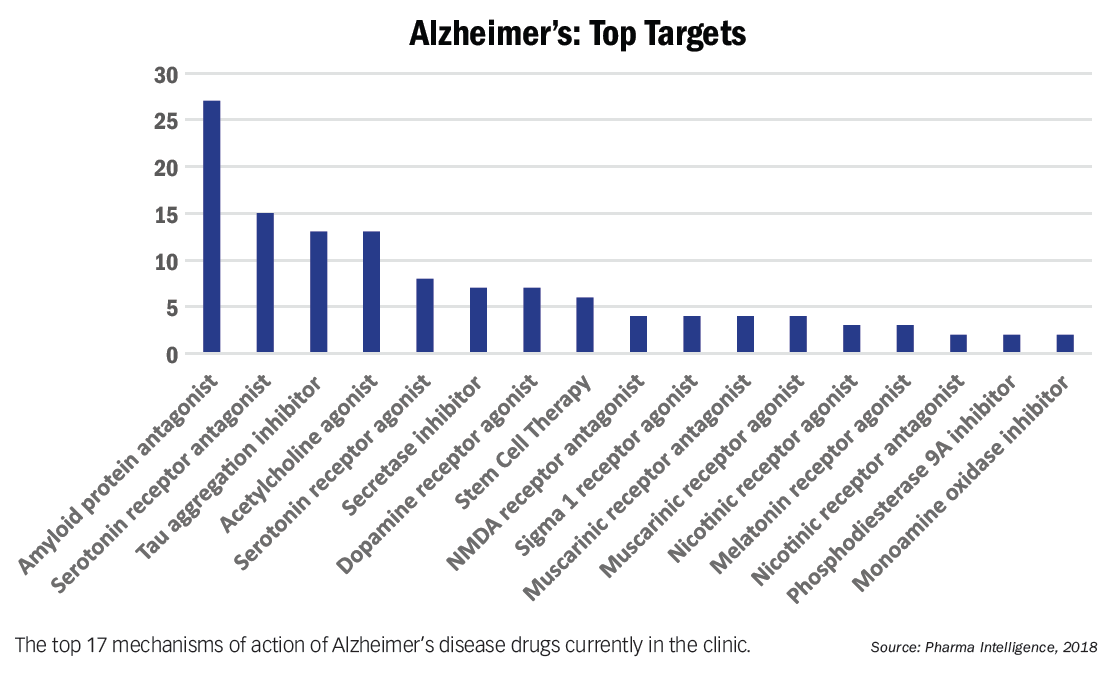
Of the drugs currently at Phase III, only four to date have shown success in meeting their primary endpoints in a Phase III trial, two that are symptom-modifying, and two that are potentially disease-modifying. The symptom modifiers are Otsuka/Lundbeck’s brexpiprazole, a dopamine/serotonin receptor modifier for agitation in Alzheimer’s, and Shanghai Green Valley Pharma’s sodium oligo-mannurarate for cognition. The disease modifiers are Roche’s gantenerumab, an amyloid antagonist, and TauRx’s LMTX, a tau aggregation inhibitor.
The industry maintains hope that a new drug to treat the underlying disease in early/pre-Alzheimer’s patients will still be found. Currently, though, drug mechanisms in development to treat Alzheimer’s symptoms still predominate, and the best endpoints to use in trials within this patient population are still being elucidated.
- Laurie Withington, PhD, is Principal Analyst, CNS, Autoimmune/Inflammation & Ophthalmology, Citeline, part of Pharma Intelligence | Informa
Next page, opioids ...
Painful detours of opioid therapeutics
Pain management is one of the most prolific areas of clinical research, with an ever-increasing population that are living with acute or chronic pain. Opioids has been the go-to solution for treating pain because they are effective. However, the effectiveness of opioids comes with the potential of addiction. The opioid addiction epidemic has reached an all-hands-on-deck situation, from government stepping in to propose new prescription limitations, passing new laws, influencing payers (pharmacies and insurance carriers), and educating physicians and the general public.
The pressure of an emerging crisis gives way to new opportunities for drug companies to innovate and hunt for that nextblock buster. Clinical development of pain therapeutics is a relative mature market, with many approved and generic drug competitions currently on the market. Global development status of opioids showed that most compounds are already launched, and the number of Phase II and III candidates are low compared to early phases (preclinical and Phase I). Since many of the approved opioids are reformulations of opioids that have already been widely launched, the burden to demonstrate efficacy is reduced compared to that of new drugs in other diseases; therefore, the distribution of drugs is pushed toward launched status.
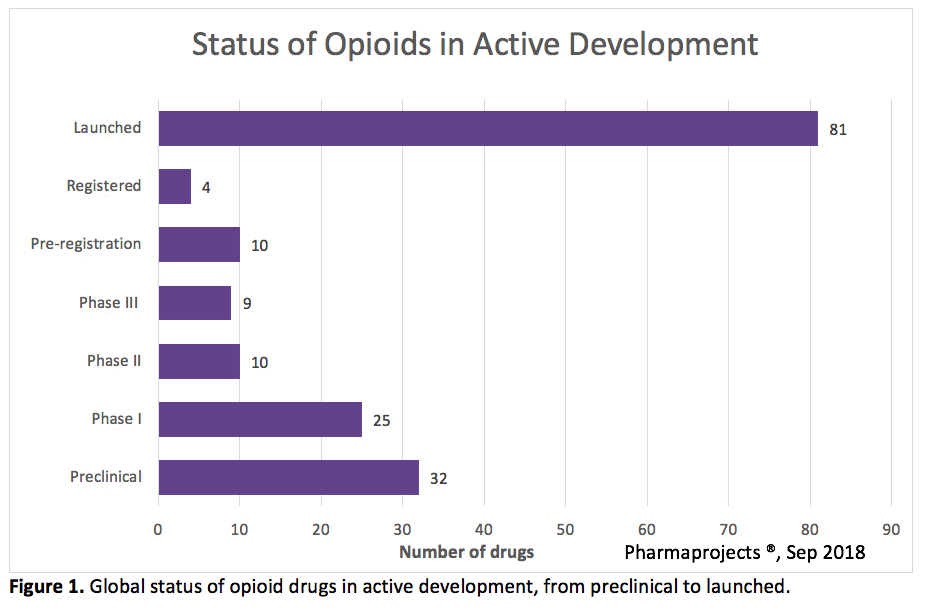
The number of clinical trials in opioids has been on a rise since the early 2000. Johnson & Johnson, Grünenthal, and Purdue rank as top industry sponsors with the most clinical trials, as demonstrated in Figure 2. The make-up of industry sponsors showed a mix of large pharmas, small to mid-sized pharmas, and specialty “boutique” drug companies.
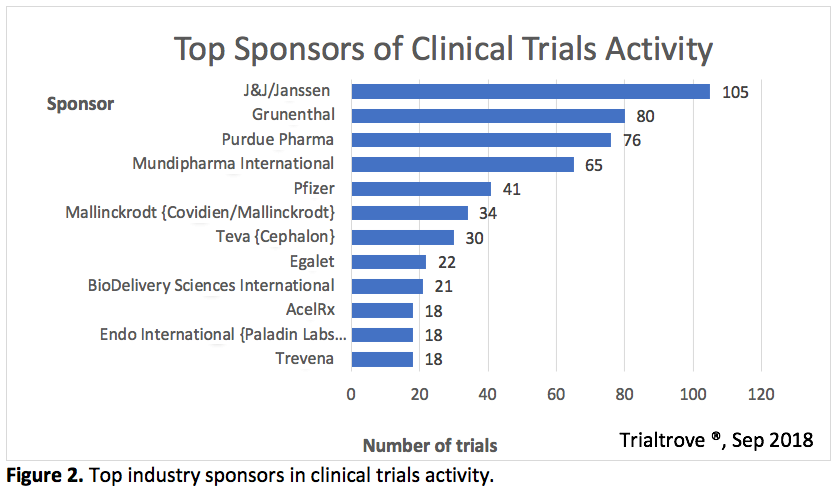
Geographical distribution of clinical trials shows that US has a significant lead worldwide (see Figure 3). China leads in the Asia-Pacific region, and the top European countries include the EU5 major markets such as France, UK, Germany, and Italy.
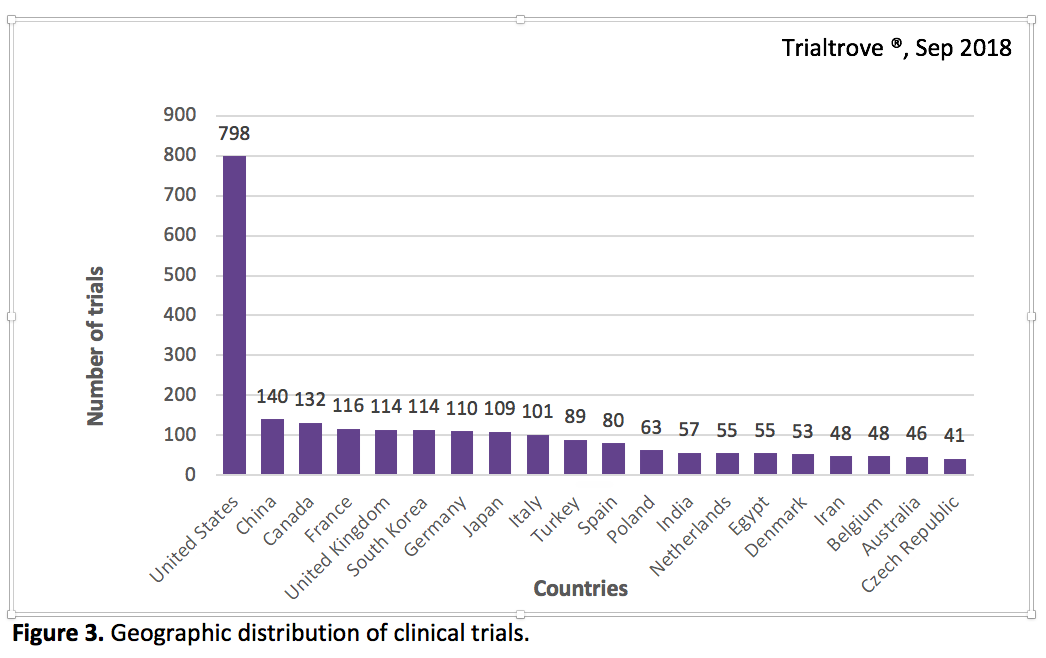
Between 2010-2016, much efforts were invested in the development of abuse-deterrent opioids. In 2010, Purdue introduced the first abuse-deterrent opioid in the US market, a newly formulated OxyContin utilizing a proprietary Intac technology from Grünenthal. This marked the beginning of the race in abuse-deterrent opioid formulations (ADFs), with the hopes of discovering the next big blockbuster pain killer. Within a few years, however, the promise of abuse-deterrent opioids seemed to dwindle with disappointing market results. One of the major hurdles is getting traction on payers because abuse-deterrence comes with a hefty price tag.
Since 2010, the FDA had approved at least 12 drugs with abuse-deterrent characteristics, but not all of them are available in the US market. Teva’s Vantrela received approval in 2017, but in February this year, the

company announced that there is no plan to commercialize this drug. KemPharm’s Apadaz recently received FDA approval in February, but it was without the abuse-deterrent labeling. Instead of commercializing it, KemPharm has been seeking a generic drug partner to off load Apadaz, as the prospect of abuse-deterrent opioids without FDA labeling is not promising in potential sales.
Endo’s Opana ER is another example. This crush-resistant formulation was launched in 2012, but it never received FDA labeling for abuse-deterrence claim, and the product was withdrawn from the market in 2017 due to intravenous abuse concerns. Purdue’s Targiniq ER has been “benched” since its approval in 2014, as Purdue continues to keep its eyes on the market trends. Pfizer’s Troxyca is in a similar boat since its approval with an abuse-deterrent label in 2016.
However, Daiichi-Sankyo is still planning to launch Roxybond (Inspiron). Elite Pharmaceutical and Egalet are still pushing forward with their naltrexone/oxycodone fixed-dose combination and oxycodone ER, respectively. Currently, Egalet, Acura, and Elite are among the top sponsors with the most clinical activity in Phase I-III development.
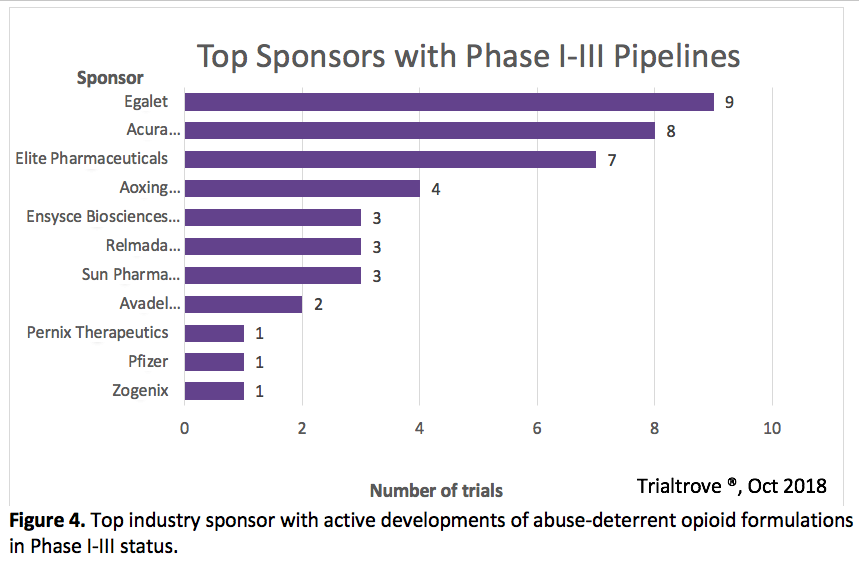
A closer look at the trial activity in Phase I-III of ADFs in Figure 5 showed a different picture than development status of all opioids in Figure 1. Here, we see a rather healthy pipeline, where Phase I dominates the scene, with a smaller presence of the late phase (Phase III).
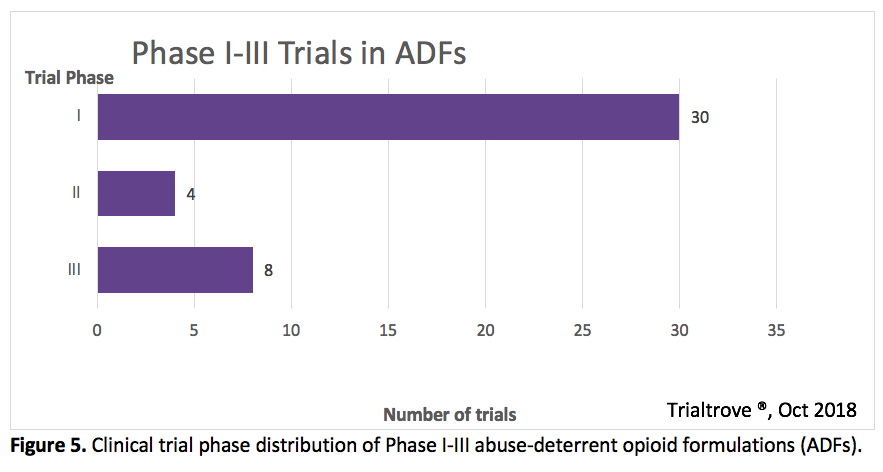
Despite hurdles from payers and the continuing challenge in finding the appropriate balance between patient access and rising abuse, the journey to battle the opioid epidemic continues. Massachusetts is the first state to pass legislation requiring payers to automatically substitute ADFs for equivalent opioids at no additional cost burden to patients; a few more other states followed suit, and the same bill has been introduced to 20 other states.
The development of abuse-deterrent opioids is just one piece in a complex matrix of strategy to combat the opioid epidemic. Development of non-opioid pain treatment targeting sodium channels like NaV1.7 is generating positive leads. Some researchers are also looking to biologicals and natural product routes to circumvent abuse potential and opioid-related side effects.
The road to battle the opioid addiction crisis was thought to be a race at the start, but it has proven to be a road with unexpected detours. The reward of a blockbuster pain killer that truly deters abuse may still be out there, but it would require a skillful navigation through the complex dynamic of evolving abuse patterns, regulatory changes, and solid sales forecast.
- Heidi Chen, PhD, is Principal Analyst, CNS, Autoimmune/Inflammation & Ophthalmology, Citeline, part of Pharma Intelligence | Informa
Next page, cannabis ...
First FDA-approved, plant-based cannabidiol marks big changes for medical marijuana
June 25, 2018, marked the FDA's milestone approval of GW Pharmaceutical’s liquid pharmaceutical formulation of cannabidiol (CBD), Epidiolex, the first FDA-approved cannabis-derived drug.1,2 The consequential Drug Enforcement Administration rescheduling of CBD from illicit Schedule I status to Schedule V raised questions over whether cannabis itself could undergo reform.3 While Epidiolex’s story garnered substantial media traction and led to regulatory repercussions for certain medicinal cannabinoids, cannabis itself is considered separately. This is due to its complexity, as the plant contains hundreds of different cannabinoids, which are present in vastly variable levels.
The extensive stringency of drug regulations has been reflected in the historically slow and sparse success of cannabinoid products in reaching the market. Cesamet (nabilone; Mylan) and Marinol (dronabinol; Abbott Laboratories) were the first to reach the market in the 1980s. Thereafter, the medicinal cannabis market remained stagnant for a period of about 20 years before Sativex’s (nabiximols; GW Pharmaceuticals) market entry in 2005. It took just over another decade for the latest addition, INSYS Therapeutics’ Syndros (dronabinol), to become the fourth marketed medicinal cannabis product. Considering that the number of drugs in development has grown from an initial three to 78 during 1995–2018, according to Pharmaprojects, the relatively small proportion of marketed drugs underlines a low success rate.
In contrast to the small number of available synthetic tetrahydrocannabinol (THC) products in the US, Epidiolex is the first plant-based CBD to be approved by the FDA. Many qualities including THC/CBD content, drug origin (synthetic/natural), and drug formulation are important regarding the quality assurance for approved medications and contribute to their abuse potential, which is a determinant of accessibility. According to Pharmaprojects, there are 50 synthetic cannabinoid receptor agonists in development versus 26 plant-based ones, and oral formulations appear to be the preferred choice for investigators. Synthetic cannabinoids may be designed to be more potent than phytocannabinoids and manipulated for increased stability.
Epidiolex is part of the trend manifesting in the past five years, with an upsurge in global clinical development as medicinal cannabinoids have attracted broad interest. The number of clinical development programs involving cannabinoid receptor agonists has almost tripled from 28 to 78. Increased activity, markedly skewed towards the preclinical segment, has rounded out the pipeline. The potential of medicinal cannabinoids has captured the attentions of a notable big pharma company, Novartis, and a biopharmaceutical company, Nemus Bioscience, which boasts the broadest cannabinoid portfolio with seven drugs in early-phase development.
The 2018 global pipeline snapshot reveals that there are 60 companies involved in developing cannabinoid receptor agonists for 92 indications, ranging from epilepsy to glaucoma. Almost a third of these companies are involved in the development of more than one cannabinoid drug. The central nervous system is the principal targeted therapy area, with a particular focus on pain indications Pharmaprojects finds. Although the precise role of cannabinoids in medicine is yet to be defined, the potential for cannabinoids to provide pain management without the use of powerful, addictive opioids is an exciting prospect.
- Stephanie Yip is an Analyst with Datamonitor Healthcare, part of Pharma Intelligence | informa
References
1. FDA (2018) FDA approves first drug comprised of an active ingredient derived from marijuana to treat rare, severe forms of epilepsy. Available from: https://www.fda.gov/NewsEvents/Newsroom/PressAnnouncements/ucm611046.htm (Accessed Oct. 2, 2018).
2. GW Pharmaceuticals (2018) GW Pharmaceuticals plc and its U.S. Subsidiary Greenwich Biosciences Announce FDA Approval of EPIDIOLEX® (cannabidiol) oral solution – the First Plant-derived Cannabinoid Prescription Medicine. Available from: https://www.gwpharm.com/about-us/news/gw-pharmaceuticals-plc-and-its-us-subsidiary-greenwich-biosciences-announce-fda (Accessed Oct. 2, 2018).
3. GW Pharmaceuticals (2018) GW Pharmaceuticals plc and its U.S. Subsidiary Greenwich Biosciences Announce the DEA has Rescheduled EPIDIOLEX® (cannabidiol) Oral Solution to Schedule V. Available from: https://www.gwpharm.com/about-us/news/gw-pharmaceuticals-plc-and-its-us-subsidiary-greenwich-biosciences-announce-dea-has (Accessed Oct. 2, 2018).
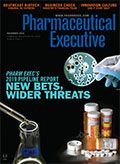
Addressing Disparities in Psoriasis Trials: Takeda's Strategies for Inclusivity in Clinical Research
April 14th 2025LaShell Robinson, Head of Global Feasibility and Trial Equity at Takeda, speaks about the company's strategies to engage patients in underrepresented populations in its phase III psoriasis trials.
Key Findings of the NIAGARA and HIMALAYA Trials
November 8th 2024In this episode of the Pharmaceutical Executive podcast, Shubh Goel, head of immuno-oncology, gastrointestinal tumors, US oncology business unit, AstraZeneca, discusses the findings of the NIAGARA trial in bladder cancer and the significance of the five-year overall survival data from the HIMALAYA trial, particularly the long-term efficacy of the STRIDE regimen for unresectable liver cancer.
Expanding Immune Response Testing to Support Vaccine Development
April 22nd 2025Nigel McCracken, chief operating officer, Virax Biolabs, discusses the expansion of its ViraxImmune platform into areas such as transplant monitoring, vaccine efficacy, latent virus reactivation, and CAR T cell therapy.